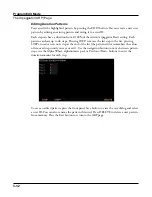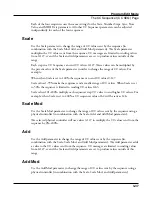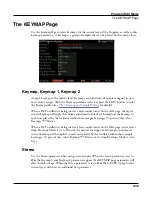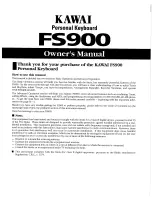
Program Edit Mode
The Arpeggiator (ARP) Page
3-26
Arpeggiator Classic Mode Parameters
Beats
The Beats parameter sets the number of notes per beat. The tempo is based on quarter notes.
Therefore, if you set Beats to 1/4, you will get one note per beat of the clock. At 1/16, you
will get 4 notes per beat, and so forth. The maximum value is 96 notes per beat (1/384), but
at most tempos, divisions smaller than 1/64 will sound pretty much the same.
To find a Beats value, multiply the notes you want per beat by 4. For example, 4 notes per
beat (16th notes) would be 4*4=16, a Beats value of 1/16. Three notes per beat (8th note
triplets) would be 3*4=12, a Beats value of 1/12. Six notes per beat (16th note triplets)
would be 6*4=24, a Beats value of 1/24.
Shift Mode
Use the Shift Mode parameter to set how the arpeggiator will shift the pitch of played notes.
The Alg (algorithm) setting will let you create note sequences based upon a fixed Shift
Amount. When you select Patt (pattern), the Shift Pattern parameter will appear, allowing
you to select a preset or user defined shift pattern. See Shift Pattern below for details.
Shift Limit
When the Shift (Shift Amount) parameter is set to a value other than 0, Shift Limit
determines how far up or down the Arpeggiator can shift the arpeggiated notes. Try setting
Shift Limit to 12 or 24 to create an arpeggio that repeats the same pattern of notes in
different octaves. This works well when Shift (Shift Amount) is set to 12 or when a Shift
Pattern is selected.
Shift Amount
When the Shift Mode is set to Alg, Shift Amount appears. Shift Amount determines how
much transposition will occur for each cycle of notes. Try setting Shift Amount to 12,
and Shift Limit to 12 or 24 to create an arpeggio that repeats the same pattern of notes in
different octaves.
Shift Pattern
When Shift Mode is set to Pattern, the Shift Pattern parameter appears, which allows you to
select a step sequence for arpeggiator note patterns. The note number of each played key is
shifted according to a sequenced pattern, thus “Shift Pattern.” There are pre-programed shift
patterns including many useful chords, intervals, and rhythms. You can also create a custom
user pattern using the pattern editor (see below for details).
Shift Pattern steps are played back at the rate set for Beats. Keep in mind that Shift Patterns
are affected by every parameter on the ARP page, which can be the cause of unexpected
variation, or a way to add interesting variation to a pattern.
Содержание Flash Play PC4
Страница 1: ... It s the sound Part Number 910587 002 Rev B ...
Страница 9: ... ix MIDI Implementation A 1 Specifications B 1 Index I 1 ...
Страница 289: ... 8 40 ...
Страница 328: ... 10 7 ...
















































